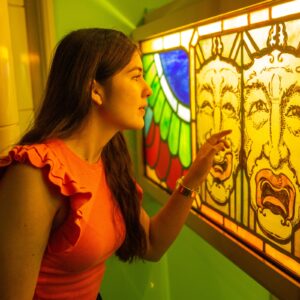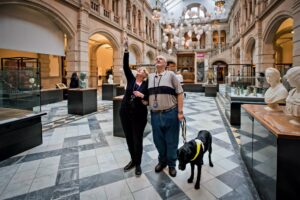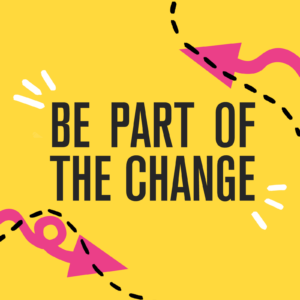Focus on: inclusion in action
What can museums and galleries do to become more inclusive spaces? Our monthly spotlight on Scotland’s museums and galleries strategy shares insights from members of the museum sector who have been putting inclusion at the heart of their work.
This edition features inclusive approaches to working with human remains at the University of Edinburgh, the steps that Timespan are taking to put anti-oppression into practice, and the positive impact of highlighting LGBTQ+ voices at Perth Museum.

What is the inclusion priority area?
Inclusive museums and galleries work with a diverse range of people to support them to tell their stories, creating an environment where all people feel safe, welcome, and engaged.
This is one of the ten priorities of Scotland’s strategy for museums and galleries. You can read the inclusion priority area and actions in full here.
All people in Scotland should be able to enjoy and take part in cultural activity. By telling new stories – and by changing the way we tell existing stories – museums and galleries can become more inclusive spaces.
An inclusive approach to working with human remains
How should museums handle the human remains in their collections? Jacob O’Sullivan (he/him), a member of our internal working group on inclusion, spoke with the University of Edinburgh’s Malcolm MacCallum (he/him) about the importance of care, consent, and community engagement.
JACOB: Hi Malcolm, thanks for talking to me today. Can you tell me a bit about your role and responsibilities with the University of Edinburgh?
MALCOLM: Hi, I’m the curator at the Anatomical Museum, which is based in the University’s Medical School. I manage all aspects of the museum, from academic and public engagement to collections management, Accreditation and grant applications, repatriation of human remains, and using the collections in University teaching.
We are a very small team of two people, so my role also includes social media, online exhibitions, general supervision, and organising our monthly public open days.
JACOB: I understand that you’ve been working with the Sudanese human remains that are in the museum’s collection. How and why were these human remains collected, and what approaches do you take in caring for them?
MALCOLM: During the 19th and early 20th centuries the University was a major collector of skulls to be used in the study of anatomy, anthropology and craniometry.
This included the acquisition of the remains of Mahdist Sudanese killed by the British at the Battle of Omdurman in 1898.
We know that one of these skulls was taken without permission from the battlefield by Henry Wellcome, the pharmaceutical entrepreneur and collector. Wellcome sent a number of skulls to UK museums, with the skull in Edinburgh entering the collection in 1900-1901.
Our approach to caring for these individuals centres on principles of respect and dignity. The remains are not on public display, but are kept in a designated area of our store, until such time as they can be repatriated.
JACOB: Museums can sometimes struggle to identify the most appropriate community or community representative to contact. How did you first reach out to the Sudanese community in Edinburgh?
MALCOLM: We were fortunate that the University already had a strong connection with the Edinburgh Sudanese community who had been working with colleagues in the University archives. This allowed us to develop links with them to look at the Anatomy collections.
In the past we have also worked with individual international students who have a specific interest in our collections. In some cases they have also introduced us to their wider community groups.

JACOB: What key pieces of advice would you give to museums wishing to include communities in collections management?
MALCOLM: You have to be very focused in what you want to achieve and be very clear from the outset about the remit of the engagement.
A lot of work around repatriation is carried out confidentially between the institution and the receiving community: it is, however, possible to collaborate very successfully in areas such as exploring how certain items came to the museum and understanding the cultural or spiritual significance of these items.
JACOB: Have you ensured the relationships last after the project?
MALCOLM: We hope to use the work with the Sudanese community in Edinburgh as a potential template for working with other communities. We are in the process of becoming an exhibition partner with the Sudanese community to further tell their story by using the human remains and other artefacts from Sudan.
It’s important to say that some communities or groups don’t particularly want to continue relationships after a repatriation is completed: each relationship is unique and comes with its own parameters.
JACOB: Why is it so important for museums to take an inclusive approach to human remains?
MALCOLM: I believe museums have a duty of care to the individuals in their collections, the vast majority of whom have not consented to being there.
Although we generally do not know the names of the individuals in museum collections, it is important that we learn their cultural, religious, and/or historic importance and appreciate the sensitivities around things like storage and display. Working in an inclusive way with other communities is the best way to do this.
JACOB: Thanks for sharing this insight into your work, Malcolm. An understanding of the cultural and spiritual significance of items to communities should be a fundamental aspect of collections care and management. It can also generate the mutual respect and understanding which leads to lasting relationships with these communities.
📢 If you’d like to discuss anything regarding the management or repatriation of human remains, please contact Jacob to find out more.
Putting anti-oppression into practice
✊ Timespan is a member of our Delivering Change programme, which encourages museums and galleries to remove barriers to access by applying anti-oppression principles to their work. Giulia Gregnanin (she/her), Director at Timespan, explains how her organisation is taking action to become more inclusive.
“We are thrilled to be part of the Delivering Change programme. As a small-scale organisation in the rural Highlands, Timespan is dedicated to using culture as a catalyst for political, social, cultural, environmental, and communal change. We recognise that museums are not neutral and have historically played significant roles in misrepresenting cultures and supporting exclusionary national narratives based on race, gender, and class.
From our rural community perspective, we address the intertwined issues of climate change and colonialism, reflecting on capitalism’s injustices and expanding the anthropic perspective on oppression.
In 2020, we opened the exhibition Real Rights, which addressed the profits made by the Highlands from the extraction of natural resources and the exploitation of colonised peoples, discussing the geo-specific reparations needed. We are working towards redeveloping our museum, starting from the foundation laid by this exhibition, and revisiting our heritage museum through the lens of colonialism and climate change.
Currently, we are reflecting on more-than-human oppression, particularly on the reasons and consequences of human intentional separation from nature. Our latest exhibition We Move As A Murmuration examines our relationship with birds, highlighting the catastrophic effects of environmental commodification by extractive capitalism, which designates birds as a “sacrifice zone” for profit. Ornithology as a scientific discipline coincided with colonialism, often disregarding Indigenous cultures and perpetuating exploitation. Conversely, birds have historically symbolised freedom and resistance against oppression.
We are really eager to embrace a journey of learning and unlearning, reflecting on and challenging ingrained social norms and structures. Being a small organisation allows us to involve all Timespan’s team—volunteers, finance, front-of-house, fundraising, curatorial teams, and board members—in our anti-oppression efforts.”

📢 Sign-ups are now open for Delivering Change: Museum Activists, a free anti-oppression programme offering training and support to help all people to access culture. Any group or individual in Scotland who works, freelances, or volunteers in the museum sector is welcome to apply.
Highlighting LGBTQ+ voices in museums
🦄 By giving space to more diverse voices, museums and galleries can help create more inclusive communities. Ashleigh Hibbins (they/them), Head of Audiences and Learning at Culture Perth and Kinross, describes the powerful impact of featuring LGBTQ+ perspectives in Perth Museum’s inaugural exhibition.
“When the new Perth Museum opened in March, we wanted to make a bold statement about our priorities. That’s why we chose to centre LGBTQ+ stories and voices in our first major exhibition, Unicorn. As part of a 4-room exploration of Scotland’s national animal, the exhibition features 5 new artworks by Scottish LGBTQ+ artists, objects and oral histories from the local community, and a queer-friendly family space.
Ahead of opening, there were some fears that Unicorn wouldn’t be ‘mainstream’ or ‘family-friendly’ enough to land in rural Scotland. We were right to give audiences the benefit of the doubt; the exhibition has been both a critical and commercial success, generating nearly £50K in ticket sales in the first 3 months and earning 5-star reviews and award nominations.
As a non-binary person, our sector can sometimes be an alienating place. Investing resource into representing queer experiences has been empowering for both audiences and staff who identify as LGBTQ+. When you put something in a museum, you give it value and legitimacy; this is the power our sector has to change society.
This type of work requires bravery. Although most feedback about Unicorn has been positive, we do get occasional homophobic and transphobic comments. It’s important to put safeguards in place to protect staff safety and wellbeing. These comments don’t deter us, but rather provide more evidence for the urgent need to centre marginalised voices in museums.”

📢 Unicorn is open daily at Perth Museum until September 22nd 2024. Read more or book tickets here.
Find out more
Thank you to Malcolm, Giulia, and Ashleigh for sharing how inclusivity has shaped their ways of working. If you’re wanting to learn more about inclusion, we have plenty of useful resources in our Focus On: Inclusion blog article. You can also contact us for further advice and support.
We hope you enjoyed this edition of Focus On. Next edition we’ll be highlighting the benefits of partnerships and knowledge sharing in Focus on: collaboration in action.


